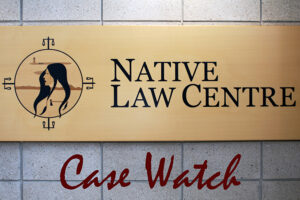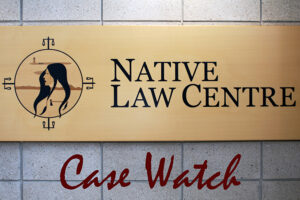FROM OUR PUBLICATIONS DESK

The following decisions came across our desk over the past month:
Crown’s duty to consult in multi-stage permitting process –
Listuguj Mi’gmaq First Nation v New Brunswick, 2016 NBQB 138: The New Brunswick Court of Queen’s Bench dismissed an application for judicial review to quash three provincial approvals granted to Chaleur Terminals Inc for the construction of a rail terminal and transfer system in Belledune, New Brunswick. The applicants argued that these approvals were issued without any meaningful consultation or accommodation of the Aboriginal and treaty rights and title of three Mi’gmaq communities along the Gaspé peninsula of Quebec. The Court rejected this application on the basis that the Crown had met the low level of consultation that it had pre-determined to be adequate for this project in 2014. The Crown first conducted its own assessment of the appropriate level of consultation in July 2014 and issued a certificate for the project to proceed at that time. The applicants never challenged those 2014 decisions and were now out of time to do so. The application was allowed to proceed with respect to three approvals from 2015 that involved excavation, the clearing of the site, and the installation of oil tanks. However, there was no new information brought to the province’s attention that would justify deeper consultation on the 2015 approvals and the province met the low level of consultation mandated by its 2014 determination.
Use of actuarial risk assessment tools for Aboriginal offenders –
Canada v Ewert, 2016 FCA 203: The Federal Court of Appeal allowed the Crown’s appeal from a Federal Court decision that concluded that the use of certain actuarial tools for assessing recidivism and psychopathy was unreliable with respect to Aboriginal inmates, and thereby unjustifiably infringed upon their section 7 rights and breached the statutory obligations of the Correctional Service of Canada. The Federal Court had held that Mr. Ewert was not required “to establish definitively” that the assessment tools were biased, but the Court of Appeal disagreed. It allowed the appeal on the basis that Mr. Ewert was required to prove on a balance of probabilities that the actuarial tools generate or were likely to generate false results for Aboriginal inmates, and failed to do so.
Gladue factors in sentencing –
R v Okimaw, 2016 ABCA 246: The Alberta Court of Appeal allowed the sentence appeal of an Aboriginal offender on the grounds that, among other things, the sentencing judge failed to give weight to specific Gladue factors. The Court of Appeal used this decision as an opportunity to provide a “practical framework” for the consideration of Gladue factors. It was not enough for the sentencing judge to merely acknowledge “the existence of systemic factors”; the judge had a duty to consider how unique systemic and background factors played a role in bringing the particular Aboriginal offender before the courts. The Court of Appeal found that this necessary context was effectively absent from, or at least given insufficient weight in the decision under review. The Court of Appeal also clarified that it is not incumbent on a Gladue report writer to explain the impact of Gladue factors on moral blameworthiness. It is the sentencing judge that has the duty to carry out an “individualized assessment” of Gladue factors and this duty cannot be delegated. In this case, the Court of Appeal found that the impact of Mr. Okimaw’s Gladue factors were “largely self-explanatory”.
R v Alec, 2016 BCCA 347: The British Columbia Court of Appeal dismissed the sentence appeal of an Aboriginal offender who was sentenced without the aid of a Gladue report. A report was allowed as fresh evidence on appeal. However, the Court of Appeal held that a “formal” Gladue report was not necessary for sentencing Aboriginal offenders. The Court held that the sentencing judge was clearly aware of Mr. Alec’s Aboriginal circumstances and his “disconnection” from his First Nation, and it was open to the sentencing judge to assume that Mr. Alec would not participate in the preparation of a report given his previous reluctance to do so.
R v Sateana, 2016 NUCJ 20: The Nunavut Court of Justice considered Gladue factors in sentencing an Aboriginal man for manslaughter. The Court stated that the systemic factors that influence criminality in Nunavut are well known and well documented, including the inter-generational impact of residential schools, over-crowded and sub-standard housing, poverty, high rates of domestic violence and sexual abuse, and high rates of alcohol and substance abuse. However, the Court held that a Gladue analysis is something “which this court is called upon to give effect to on a regular basis, but which it is unable to implement in any meaningful way”. While Mr. Sateana had appeared before the Court many times before the events leading to his manslaughter conviction, the Court “would have been unable to craft sentences which addressed his deep seated issues and alcohol addiction because the territory has no treatment or rehabilitation facilities and few counselling and mental health services.” Mr. Sateana was sentenced to 13 years incarceration.
Gladue factors in relation to solitary confinement –
Hamm v Canada (Attorney General), 2016 ABQB 440: The Alberta Court of Queen’s Bench allowed an application for habeas corpus from three self-represented inmates placed in solitary confinement, two of whom were Aboriginal. The Court ordered the release of these three inmates from segregation as the institution had failed to provide them with the high level of procedural fairness they were owed before being placed into solitary confinement. Among other concerns, the Court held that “given the potential rehabilitation benefits and other benefits of access to [A]boriginal spiritual and cultural programs, each [A]boriginal inmate should have had a Gladue type assessment of what placements would be appropriate.” The Court also concluded that it was “unreasonable for a correctional institution to deny transparency in relation to its decisions concerning whether, and how, and where, [A]boriginal offenders should be further deprived of liberty”.
Gladue factors & pledges of on-reserve property in bail hearing –
R v Hope, 2016 ONCA 648: The Ontario Court of Appeal granted an Aboriginal man release from custody pending a new trial on charges that include second degree murder. The Court of Appeal took note of the various contexts in which it has previously applied Gladue principles, including bail hearings, and stated that Gladue principles informed certain aspects of its analysis in this case. Ultimately, the Court concluded that detention pending appeal was not necessary in the public interest in this case. The Court also dismissed the Crown’s concerns with the fact that the individuals offering sureties and pledges against the equity in their homes on Mr. Hope’s behalf were of Aboriginal descent and lived on reserve. Section 89 of the Indian Act protects property on reserve from being subject to a charge by anyone other than an “Indian” or a band. The Court of Appeal held that this should not interfere with an Aboriginal person’s ability to secure release from detention, and what mattered was that these individuals expressed a willingness to pledge the “not insignificant” equity in their properties, not whether the Crown could execute against those properties.
Extinguishment of Aboriginal rights –
Québec (Procureure générale) c Lachapelle, 2016 QCCS 3961 (in French only): The Quebec Superior Court granted an application to evict two individuals from a hunting camp in the Eastmain River basin in northern Quebec. One of the respondents was a member of the Algonquins of Barriere Lake and asserted that the hunting camp was incidental to an Aboriginal right to hunt. However, the respondent failed to provide any evidence in support of a site-specific hunting right in the area in question. The Court noted that the camp was located approximately 1200km away from the respondent’s reserve and fell within Cree territory recognized under the James Bay and Northern Quebec Agreement (JBNQA). The Court also held that even if the respondent had proven a site-specific right in the area where the camp is located, the Court could not recognize it in light of the extinguishment clause in the JBNQA. The respondent declined the opportunity to challenge the JBQNA’s constitutionality. The Court did note, however, that the JBQNA’s constitutionality is at issue in another proceeding before the Superior Court.
Exceptions to the tax exemption under section 87 of the Indian Act –
Bell v Canada, 2016 TCC 175: The Tax Court of Canada dismissed an appeal from tax assessments based on the tax exemption for personal property situated on reserve (section 87 of the Indian Act). The appeal concerned whether the exemption could be applied to annual bonuses received by a status “Indian”, Ms. Bell, from a company she owned and operated with her non-status spouse. Ms. Bell worked out of an office located on reserve. Ms. Bell received regular bi-weekly pay from the company as well as the balance of the company’s annual income as year end bonuses. The Minister allowed her to rely on the tax exemption for her regular pay but not for her year end bonuses. The Tax Court upheld the Minister’s decision on the basis that there was no substantive connection between the bonuses and the reserve land where Ms. Bell was working. The Tax Court also found that the bonuses exceeded reasonable remuneration and were therefore abusive of the tax exemption.
Crowns added as parties in private law action involving Aboriginal rights –
Saik’uz First Nation v Rio Tinto Alcan Inc, 2016 BCSC 1474: The BC Supreme Court allowed an application to add both the federal and provincial Crowns as defendants to a tort action against Rio Tinto Alcan in relation to impacts on the Nechako River and its fishery resources. The action is premised in part on asserted Aboriginal rights and title. The Court noted that the plaintiffs acknowledged that the consequences of this “major and complex case”, which would define the intersection between Aboriginal rights and tort law, may be huge. This may warrant inclusion of the Crown on its own. Further, the plaintiffs had already formally invited the Crown to participate through the Notice of Constitutional Challenge they issued in order to challenge the applicability of certain statutes. Under British Columbia’s Water Act, the province also asserts ownership over the water under dispute in this action, thereby warranting its involvement. Finally, the Court held that even where a formal declaration of Aboriginal title is not sought in the pleadings, the federal and provincial Crowns are still necessary parties to the determination of issues relating to Aboriginal title.
Injunction against First Nation’s interference with use of road –
Revolution Infrastructure Inc v Lytton First Nation, 2016 BCSC 1562: The BC Supreme Court allowed an application from Revolution Infrastructure for an interlocutory injunction restraining the Lytton First Nation from prohibiting or interfering with its use of an access road and ranch on which it operates a composting facility. Lytton First Nation asserts Aboriginal rights and title to the valley in which the facility and road are located and asserts a right to control access on this basis, as well as the basis that the road crosses its reserve lands. Lytton has enacted a band bylaw requiring Revolution to obtain a permit to use the road. The Court held that there are several serious questions to be tried in this case, including the nature of Aboriginal title and whether the band bylaw was validly enacted. The Court also held that interference with Revolution’s access to the road would result in irreparable harm. Finally, the Court held that the balance of convenience favoured Revolution as Lytton’s actions had disrupted the status quo of its use of the road without interference since 2009, the road had been used by the public for a significant period before then, and a facilitation process was in place that could potentially address the issues between the parties.
No jurisdiction for provincial tribunal with respect to on-reserve clinic –
Cahoose v Ulkatcho Indian Band, 2016 BCHRT 114: The BC Human Rights Tribunal dismissed a complaint against the Ulkatcho Indian Band and others on the basis that it lacked jurisdiction over the matter. The complainant had been employed in the band’s healthcare clinic on reserve. The tribunal held that there was no dispute over the proper approach for determining the limits of its jurisdiction. Instead, the key issue was which entity the so-called “functional test” needed to be applied to. The complainant argued that the First Nations Health Authority administered the clinic. However, the tribunal found no evidence of the Authority acting as a service provider. Instead, it concluded that the band was the employer of the clinic’s staff and the entity providing medical services on the reserve. Finally, the tribunal concluded that the band’s operations were seen to be federal when the functional test was applied.
Jurisdiction of self-governing First Nation tribunal –
Kwanlin Dün First Nation v Kwanlin Dün First Nation Judicial Council, 2016 YKSC 35: The Yukon Supreme Court dismissed an appeal from the Kwanlin Dün First Nation (KDFN) against two decisions of its Judicial Council that set aside its termination of two tenancy agreements. KDFN argued that the Judicial Council had no jurisdiction to decide matters relating to landlord and tenancy issues since KDFN has not enacted any laws on this subject matter and provincial legislation therefore applies. The Court found this dispute raised a question of true jurisdiction that must be reviewed on a standard of correctness. It held that the Judicial Council, by virtue of KDFN’s Constitution and its Judicial Council Act, had the power to review administrative decisions by the KDFN, including those it makes in a landlord and tenant context, to ensure its Constitution and laws are complied with. The Court went on to conclude that the Judicial Council had not exceeded its jurisdiction by ruling on matters of procedural fairness and KDFN’s constitutional values in context to the tenancy disputes at issue. The Judicial Council did not rule on specific landlord-tenant issues.
Indian Residential Schools Settlement Agreement –
Fontaine v Canada (Attorney General), 2016 MBQB 159: The Manitoba Court of Queen’s Bench allowed a Request for Directions with respect to a claim that an individual was wrongfully denied compensation under the IRSSA for sexual abuse at a residential school. The adjudicator accepted that a nun grabbed the claimant’s genitals while he was at residential school, but was not satisfied that the act had a “sexual purpose”. This decision was upheld on review and re-review. The Court found that it had the jurisdiction to review the re-review adjudicator’s decision on a standard of reasonableness. It went on to conclude that the first adjudicator’s interpretation of the IRSSA as requiring a “sexual purpose” for sexual touching to be compensable was fundamentally inconsistent with the plain language of the IRSSA and with the criminal law jurisprudence that the adjudicator purported to apply. It was therefore unreasonable for the re-review adjudicator to uphold this decision. The Court sent the claim back to be reconsidered in accordance with its reasons.
Fontaine v Canada (Attorney General), 2016 ONSC 5359: The Ontario Superior Court of Justice addressed the results of an investigation into the legal services provided by Douglas J. Keshen and his former law firm with respect to claims under the Indian Residential Schools Settlement Agreement (IRSSA). The report resulting from the investigation was “largely a vindication for Mr. Keshen”. However, there were two exceptions to this: 1) Mr. Keshen was found to have facilitated third party loans on the basis of a promise to repay the loans from IRSSA awards, which is prohibited under the IRSSA; and 2) Mr. Keshen’s practice of reporting to clients orally rather than in writing did not fully meet the Law Society of Upper Canada’s guidelines for lawyers acting on IRSSA files. No costs were ordered for either party and Mr. Keshen was not ordered to pay the costs of the investigation.





